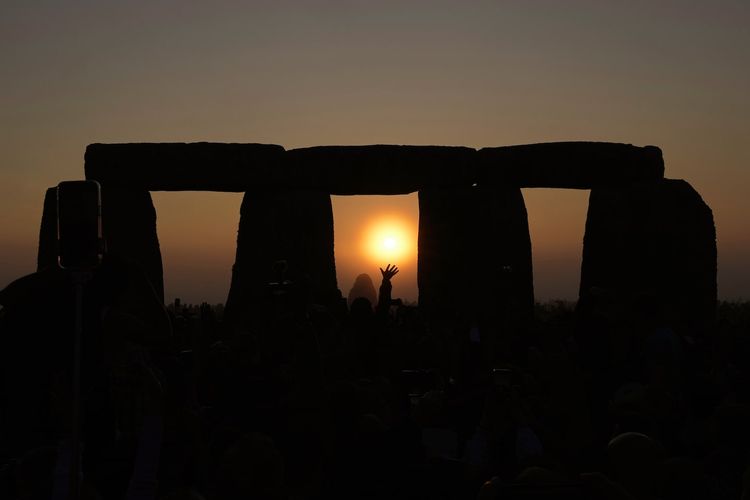Summer solstice 2024: Season to have its earliest start since 1796

Summer is arriving a bit earlier than usual this year, and not just because a major heat wave is baking the eastern United States and Canada this week. Thursday’s summer solstice — the longest day and shortest night of the year in the Northern Hemisphere — is the earliest in 228 years, since 1796, when George Washington was president.
The 2024 summer solstice arrives June 20 at 4:51 p.m. Eastern time, according to the U.S. Naval Observatory. A day later, on June 21, the full moon will rise at 9:08 p.m. Eastern. The “strawberry moon” is the lowest full moon of the year, staying close to the horizon as the sun soars to its highest point in the sky.
What exactly happens on the solstice?
In most years, the summer solstice occurs on June 21. That’s when Earth’s North Pole reaches its maximum tilt toward the sun, and the sun appears at its northernmost point directly over the Tropic of Cancer, 23.5 degrees north of Earth’s equator. In the Northern Hemisphere, the sun takes its longest and highest path through the sky, which is why we experience our longest daylight hours and shortest night of the year.
Daylight hours on the summer solstice depend on latitude: The closer you move toward the North Pole, the more time the sun spends above the horizon. The sun is up for 16 hours in Seattle, but only 13 hours and 45 minutes in Miami.
Washington, D.C., sees about 14 hours 54 minutes of daylight on the summer solstice, with sunrise at 5:42 a.m. and sunset at 8:36 p.m., according to timeanddate.com.
Two ways to observe the solstice directly are by watching your shadow as well as the location of sunrise and sunset. The high arc of the sun means you will cast your shortest midday shadow of the year on the summer solstice. You will also see the sun rise and set at its northernmost points along the horizon.
Why is the solstice early this year?
The main reason for the early solstice is that human calendars aren’t perfect. While a normal year (or non-leap year) has 365 days, Earth’s orbit around the sun each year is not exactly that long. On average, it takes about 365 days, 5 hours and 49 minutes — or 365.24219 days, according to timeanddate.com. To account for that extra quarter-day, the Gregorian calendar we adopted in the late 16th century adds one extra day (Feb. 29) to the calendar every four years. This is why we have leap years that are 366 days long.
During leap years such as 2024, the solstices and equinoxes occur about 18 hours and 11 minutes earlier than the previous year. Then, during successive non-leap years, the seasons begin 0.24219 days later than the previous year (approximately 5 hours and 49 minutes).
Over time, this means that the solstices and equinoxes drift earlier by about 45 minutes every four years, or about three-quarters of a day per century. By 2096, the solstice will occur at its earliest time of this century.
To correct this discrepancy, the Gregorian calendar introduced a special rule: Any year divisible by four is a leap year, except for century years, which can only be leap years if they are divisible by 400. Therefore, 1600 and 2000 were leap years, while 1700, 1800, 1900 and 2100 are not.
Skipping three leap years every 400 years means the average length of the Gregorian calendar we use is 365.2425 days instead of 365.25 days. Those extra decimal places may not sound like a lot, but they keep our calendar in sync with the actual time it takes Earth to orbit the sun (365.24219 days).
Without this calibration, the solstices would move earlier indefinitely. Instead, the solstices (and equinoxes) will arrive earlier with each passing leap year until the end of the 21st century. However, the cycle will eventually reset. Because 2100 is not a leap year, the time of the solstice will start to drift later again.
The reason for the seasons
Earth’s seasons occur because the planet is tilted on its axis by about 23.5 degrees, which causes each hemisphere to receive different amounts of sunlight throughout the year.
In June, the Northern Hemisphere leans toward the sun, bringing us more direct sunlight and warmer weather. In the Southern Hemisphere, the June solstice is the first day of winter and the shortest day of the year. Halfway between the winter and summer solstices are the equinoxes, when the length of day and night are nearly equal everywhere on Earth.
While the summer solstice marks the first day of astronomical summer, meteorologists define summer as the warmest three calendar months of the year, spanning June, July and August. In most of North America, the warmest three months of the year are more closely aligned with meteorological summer (June 1 to Aug. 31) than astronomical summer, according to climatologist Brian Brettschneider.
The hottest stretch of the year typically doesn’t arrive until the second half of July for much of the United States, according to the National Oceanic and Atmospheric Administration. This seasonal lag happens because the amount of solar energy arriving at the ground is greater than the amount leaving the Earth for several weeks after the solstice. It’s largely driven by the oceans, which take longer than land to warm up and cool down, and release heat slowly over time.
Yet even as summer heat starts to ramp up, we’ll slowly start to lose daylight after Thursday’s solstice.

















































